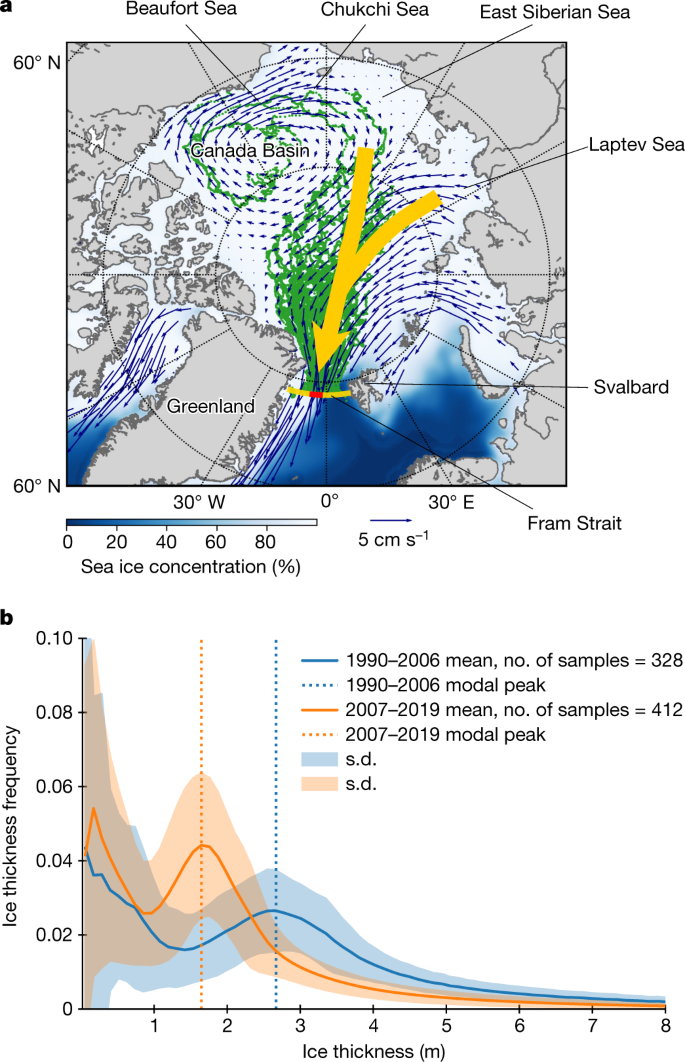THE FIRST CHRISTMAS POLAR THAW MAY NOT BE THE LAST
Nature Published:
Regime shift in Arctic Ocean sea ice thickness
Nature 615, 443–449 (2023)
Manifestations of climate change are often shown as gradual changes in physical or biogeochemical properties1. Components of the climate system, however, can show stepwise shifts from one regime to another, as a nonlinear response of the system to a changing forcing2. Here we show that the Arctic sea ice regime shifted in 2007 from thicker and deformed to thinner and more uniform ice cover. Continuous sea ice monitoring in the Fram Strait over the last three decades revealed the shift. After the shift, the fraction of thick and deformed ice dropped by half and has not recovered to date. The timing of the shift was preceded by a two-step reduction in residence time of sea ice in the Arctic Basin, initiated first in 2005 and followed by 2007. We demonstrate that a simple model describing the stochastic process of dynamic sea ice thickening explains the observed ice thickness changes as a result of the reduced residence time. Our study highlights the long-lasting impact of climate change on the Arctic sea ice through reduced residence time and its connection to the coupled ocean–sea ice processes in the adjacent marginal seas and shelves of the Arctic Ocean.
Main
The extent of Arctic sea ice exhibited negative trends both in summer and winter over the last three decades1,3. Such a retreat in summer sea ice results in an increase of open water areas and prolongation of ice-free conditions in the adjacent marginal seas and shelves of the Arctic Ocean4,5. The adjacent, ice-free seas absorb more solar energy during summer and store heat in the upper ocean6. The heat enhances ice melt in the marginal ice zone in summer and delays the onset of new ice formation in the autumn7. These processes influence Arctic-wide sea ice properties through large-scale sea ice motion carrying the ice from the marginal seas to the central Arctic, a process known as Transpolar Drift (TPD) Stream8.
a, Arctic Ocean and its marginal seas, with winter sea ice concentration (1980–2018 mean, white-blue shading, calculated from OSI SAF51), ice drift field (blue arrows, Polar Pathfinder Daily 25 km EASE-Grid Sea Ice Motion Vectors v.4.1)52, 83 ice-tethered buoy tracks that arrived in the Fram Strait (green lines) and TPD Stream (yellow shade). The buoy tracks were obtained from the International Arctic Buoy Programme53. The Fram Strait Arctic Outflow Observatory is shown by the red bar. b, Mean sea ice thickness distribution in the Fram Strait before and after 2007. The distributions were derived on a monthly basis by all available ULS data from 1990 to 2019 (described in the Methods) and averaged across two periods: 1990–2006 and 2007–2019. The Matplotlib basemap toolkit was used to plot the map.
… The Fram Strait Arctic Outflow Observatory has been monitoring sea ice and ocean properties in the core of the outflow at a latitude of approximately 79° N18 (marked red in Fig. 1a) since 1990. The observatory has provided a unique, near-continuous time series of sea ice thickness for the last three decades19(Methods).
In this study, we show that in 2007, a regime shift of sea ice thickness occurred in the Fram Strait. The shift was characterized by an abrupt reduction of deformed thick ice (a 52% reduction of sea ice thicker than 4 m) and an increased uniformity of ice thickness distribution (height of the modal peak increased by 67%)…
The distribution of sea ice thickness has changed substantially in the last three decades, reflecting the environmental changes in the Arctic and consequent reduction of mean ice thickness in the Arctic Ocean21. In the Fram Strait, the thickness of the modal peak has been reduced by approximately 1 m (2.7 m to 1.7 m...
Our analysis demonstrates the long-lasting impact of climate change on Arctic sea ice through reduced residence time, suggesting an irreversible response of Arctic sea ice thickness connected to an increase of ocean heat content in areas of ice formation. The large reduction of summer ice extent in the Alaskan and Siberian sectors in 2005 and 2007 triggered intensive ice–albedo feedback42,45 and initiated the perennial increase of ocean heat content in these areas44. This resulted in the stepwise reduction of residence time of sea ice in the Siberian sector of the Arctic, and hence a nonlinear response of the system.

